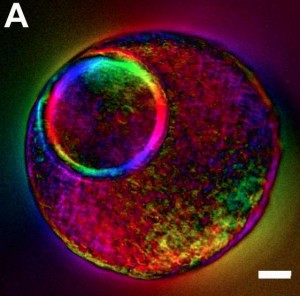 A recent article from Oncofertility Consortium members Susan Barrett, Lonnie Shea, and Teresa Woodruff, shows that human follicles, which are immature eggs, can be frozen and thawed safely. This breakthrough may give cancer survivors a greater chance at having children. While cancer treatments, such as radiation and chemotherapy, are increasingly successful at saving lives, they often disrupt the function of a woman’s ovaries.
A recent article from Oncofertility Consortium members Susan Barrett, Lonnie Shea, and Teresa Woodruff, shows that human follicles, which are immature eggs, can be frozen and thawed safely. This breakthrough may give cancer survivors a greater chance at having children. While cancer treatments, such as radiation and chemotherapy, are increasingly successful at saving lives, they often disrupt the function of a woman’s ovaries.
Currently, patients have few options to preserve their fertility prior to cancer treatment. Some women can undergo hormone stimulation to release multiple mature eggs. These eggs are frozen, in a process called cryopreservation, or else fertilized and then frozen. After successfully beating cancer, women can have these eggs or embryos thawed. Unfortunately, hormone stimulation requires a delay in treatment so women with rapidly progressing or hormone-sensitive cancers are not candidates for this type of fertility preservation. Another option is to remove and freeze ovaries for later re-implantation. Unfortunately, patients with “leukemia, lymphoma, pelvic, and some breast cancers,” are not candidates for ovarian cryopreservation, says Susan Barrett, first-author of the recent article, as there is a chance of reintroducing the cancer.
The study, published in the Biology of Reproduction, asks if immature follicles can instead be successfully cryopreserved and thawed. If so, women with immediate needs for cancer treatment and those not able to participate in ovarian re-implantation could have young follicles removed, without hormone stimulation. As Barrett describes, the team “froze and thawed mouse, primate, and human ovaries and used a vital assay,” to determine the health of ovaries (shown above). These scientists were able to “get 20 to 30 good follicles in a single ovary,” and discovered that at “About 50% of the human follicles survived the thawing process,” says Barrett, indicating that this is a real option for patients. Further research will determine how thawed follicles can be matured into an egg for fertilization. Meanwhile, researchers from the Oncofertility Consortium frequently train clinicians on these techniques, so, once perfected, they can be implemented quickly to preserve the fertility of young cancer survivors.
Read the entire article Noninvasive Index of Cryorecovery and Growth Potential for Human Follicles in Vitro

